1999 FORD F250 warning light
[x] Cancel search: warning lightPage 112 of 248
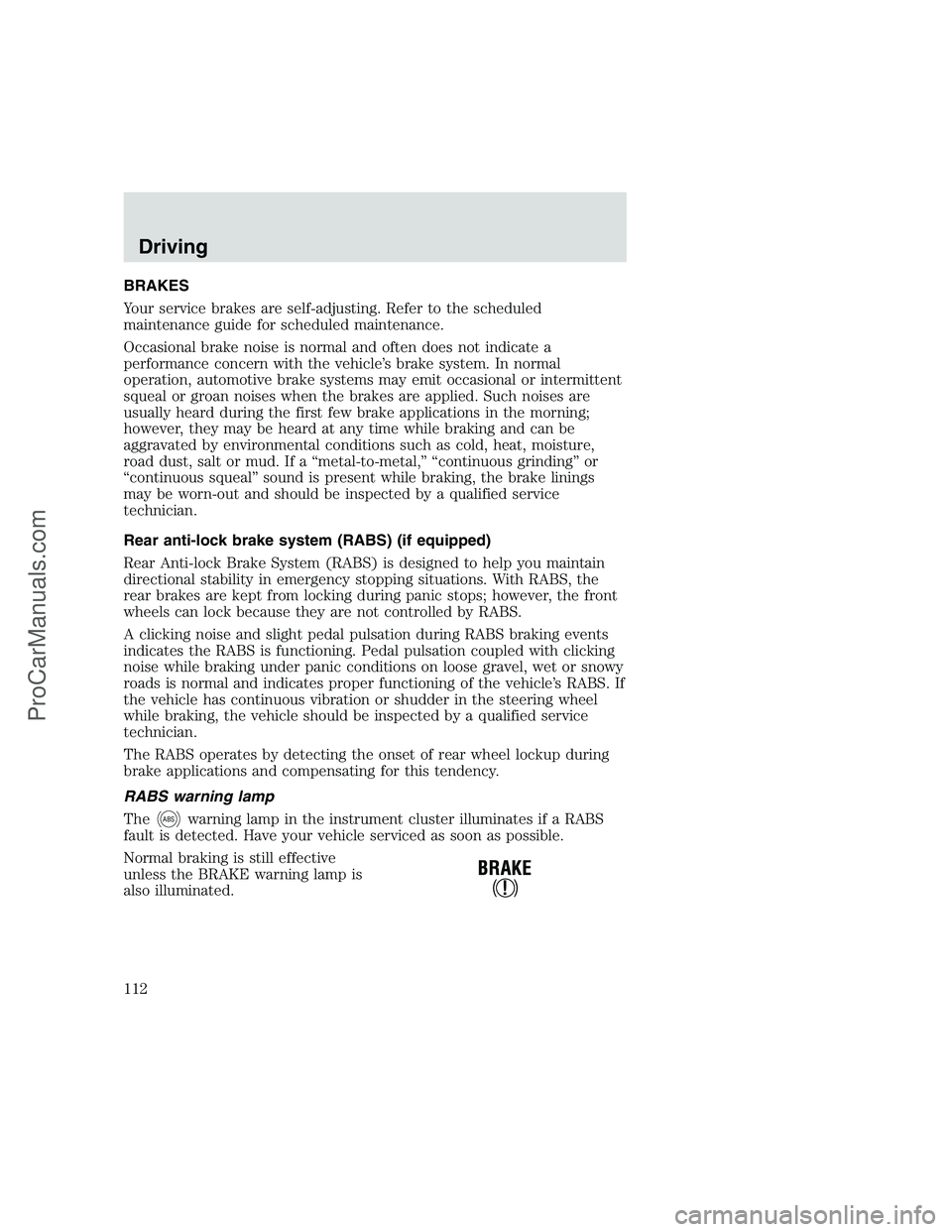
BRAKES
Your service brakes are self-adjusting. Refer to the scheduled
maintenance guide for scheduled maintenance.
Occasional brake noise is normal and often does not indicate a
performance concern with the vehicle’s brake system. In normal
operation, automotive brake systems may emit occasional or intermittent
squeal or groan noises when the brakes are applied. Such noises are
usually heard during the first few brake applications in the morning;
however, they may be heard at any time while braking and can be
aggravated by environmental conditions such as cold, heat, moisture,
road dust, salt or mud. If a “metal-to-metal,” “continuous grinding” or
“continuous squeal” sound is present while braking, the brake linings
may be worn-out and should be inspected by a qualified service
technician.
Rear anti-lock brake system (RABS) (if equipped)
Rear Anti-lock Brake System (RABS) is designed to help you maintain
directional stability in emergency stopping situations. With RABS, the
rear brakes are kept from locking during panic stops; however, the front
wheels can lock because they are not controlled by RABS.
A clicking noise and slight pedal pulsation during RABS braking events
indicates the RABS is functioning. Pedal pulsation coupled with clicking
noise while braking under panic conditions on loose gravel, wet or snowy
roads is normal and indicates proper functioning of the vehicle’s RABS. If
the vehicle has continuous vibration or shudder in the steering wheel
while braking, the vehicle should be inspected by a qualified service
technician.
The RABS operates by detecting the onset of rear wheel lockup during
brake applications and compensating for this tendency.
RABS warning lamp
The
ABSwarning lamp in the instrument cluster illuminates if a RABS
fault is detected. Have your vehicle serviced as soon as possible.
Normal braking is still effective
unless the BRAKE warning lamp is
also illuminated.
Driving
112
ProCarManuals.com
Page 113 of 248
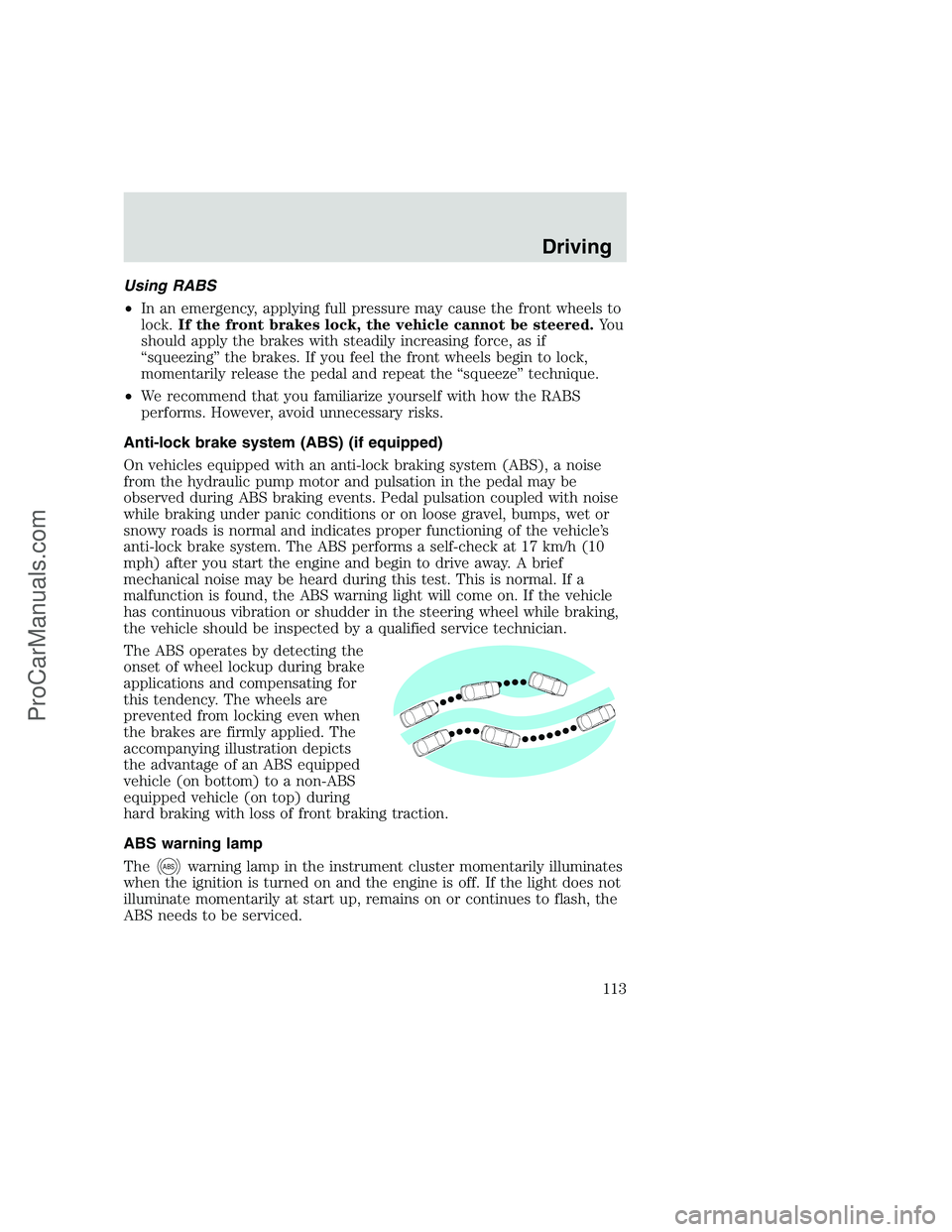
Using RABS
•In an emergency, applying full pressure may cause the front wheels to
lock.If the front brakes lock, the vehicle cannot be steered.Yo u
should apply the brakes with steadily increasing force, as if
“squeezing” the brakes. If you feel the front wheels begin to lock,
momentarily release the pedal and repeat the “squeeze” technique.
•We recommend that you familiarize yourself with how the RABS
performs. However, avoid unnecessary risks.
Anti-lock brake system (ABS) (if equipped)
On vehicles equipped with an anti-lock braking system (ABS), a noise
from the hydraulic pump motor and pulsation in the pedal may be
observed during ABS braking events. Pedal pulsation coupled with noise
while braking under panic conditions or on loose gravel, bumps, wet or
snowy roads is normal and indicates proper functioning of the vehicle’s
anti-lock brake system. The ABS performs a self-check at 17 km/h (10
mph) after you start the engine and begin to drive away. A brief
mechanical noise may be heard during this test. This is normal. If a
malfunction is found, the ABS warning light will come on. If the vehicle
has continuous vibration or shudder in the steering wheel while braking,
the vehicle should be inspected by a qualified service technician.
The ABS operates by detecting the
onset of wheel lockup during brake
applications and compensating for
this tendency. The wheels are
prevented from locking even when
the brakes are firmly applied. The
accompanying illustration depicts
the advantage of an ABS equipped
vehicle (on bottom) to a non-ABS
equipped vehicle (on top) during
hard braking with loss of front braking traction.
ABS warning lamp
The
ABSwarning lamp in the instrument cluster momentarily illuminates
when the ignition is turned on and the engine is off. If the light does not
illuminate momentarily at start up, remains on or continues to flash, the
ABS needs to be serviced.
Driving
113
ProCarManuals.com
Page 114 of 248
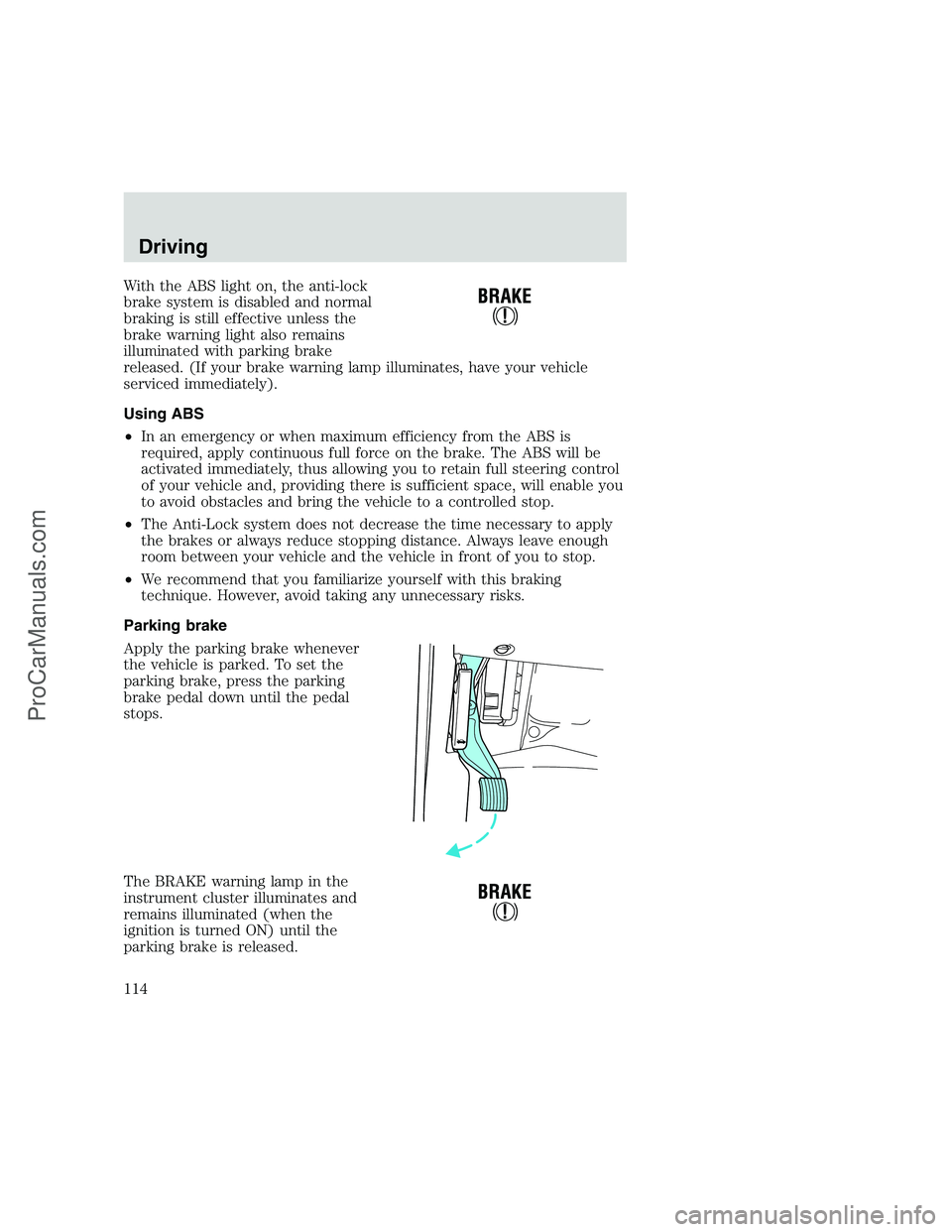
With the ABS light on, the anti-lock
brake system is disabled and normal
braking is still effective unless the
brake warning light also remains
illuminated with parking brake
released. (If your brake warning lamp illuminates, have your vehicle
serviced immediately).
Using ABS
•In an emergency or when maximum efficiency from the ABS is
required, apply continuous full force on the brake. The ABS will be
activated immediately, thus allowing you to retain full steering control
of your vehicle and, providing there is sufficient space, will enable you
to avoid obstacles and bring the vehicle to a controlled stop.
•The Anti-Lock system does not decrease the time necessary to apply
the brakes or always reduce stopping distance. Always leave enough
room between your vehicle and the vehicle in front of you to stop.
•We recommend that you familiarize yourself with this braking
technique. However, avoid taking any unnecessary risks.
Parking brake
Apply the parking brake whenever
the vehicle is parked. To set the
parking brake, press the parking
brake pedal down until the pedal
stops.
The BRAKE warning lamp in the
instrument cluster illuminates and
remains illuminated (when the
ignition is turned ON) until the
parking brake is released.
Driving
114
ProCarManuals.com
Page 202 of 248
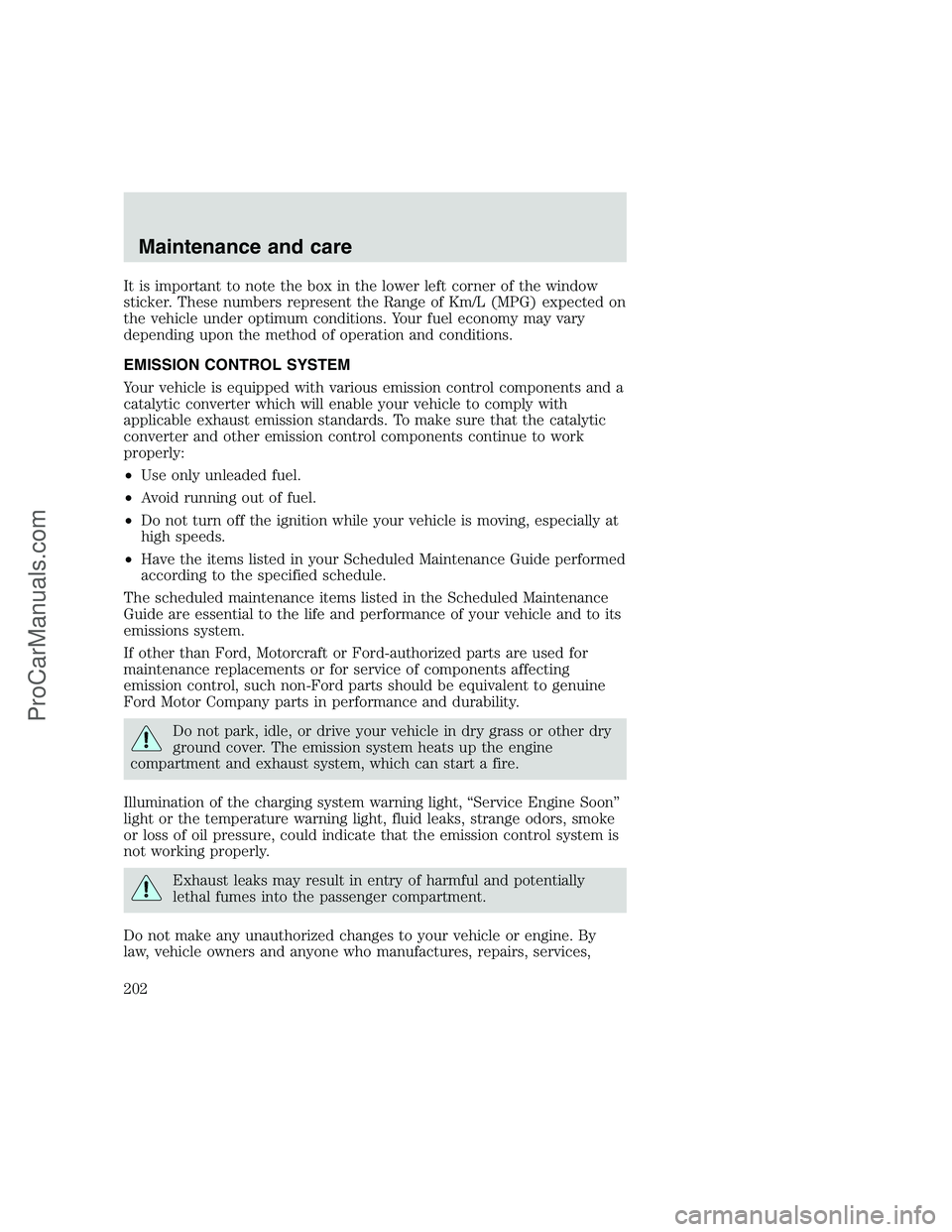
It is important to note the box in the lower left corner of the window
sticker. These numbers represent the Range of Km/L (MPG) expected on
the vehicle under optimum conditions. Your fuel economy may vary
depending upon the method of operation and conditions.
EMISSION CONTROL SYSTEM
Your vehicle is equipped with various emission control components and a
catalytic converter which will enable your vehicle to comply with
applicable exhaust emission standards. To make sure that the catalytic
converter and other emission control components continue to work
properly:
•Use only unleaded fuel.
•Avoid running out of fuel.
•Do not turn off the ignition while your vehicle is moving, especially at
high speeds.
•Have the items listed in your Scheduled Maintenance Guide performed
according to the specified schedule.
The scheduled maintenance items listed in the Scheduled Maintenance
Guide are essential to the life and performance of your vehicle and to its
emissions system.
If other than Ford, Motorcraft or Ford-authorized parts are used for
maintenance replacements or for service of components affecting
emission control, such non-Ford parts should be equivalent to genuine
Ford Motor Company parts in performance and durability.
Do not park, idle, or drive your vehicle in dry grass or other dry
ground cover. The emission system heats up the engine
compartment and exhaust system, which can start a fire.
Illumination of the charging system warning light, “Service Engine Soon”
light or the temperature warning light, fluid leaks, strange odors, smoke
or loss of oil pressure, could indicate that the emission control system is
not working properly.
Exhaust leaks may result in entry of harmful and potentially
lethal fumes into the passenger compartment.
Do not make any unauthorized changes to your vehicle or engine. By
law, vehicle owners and anyone who manufactures, repairs, services,
Maintenance and care
202
ProCarManuals.com
Page 203 of 248
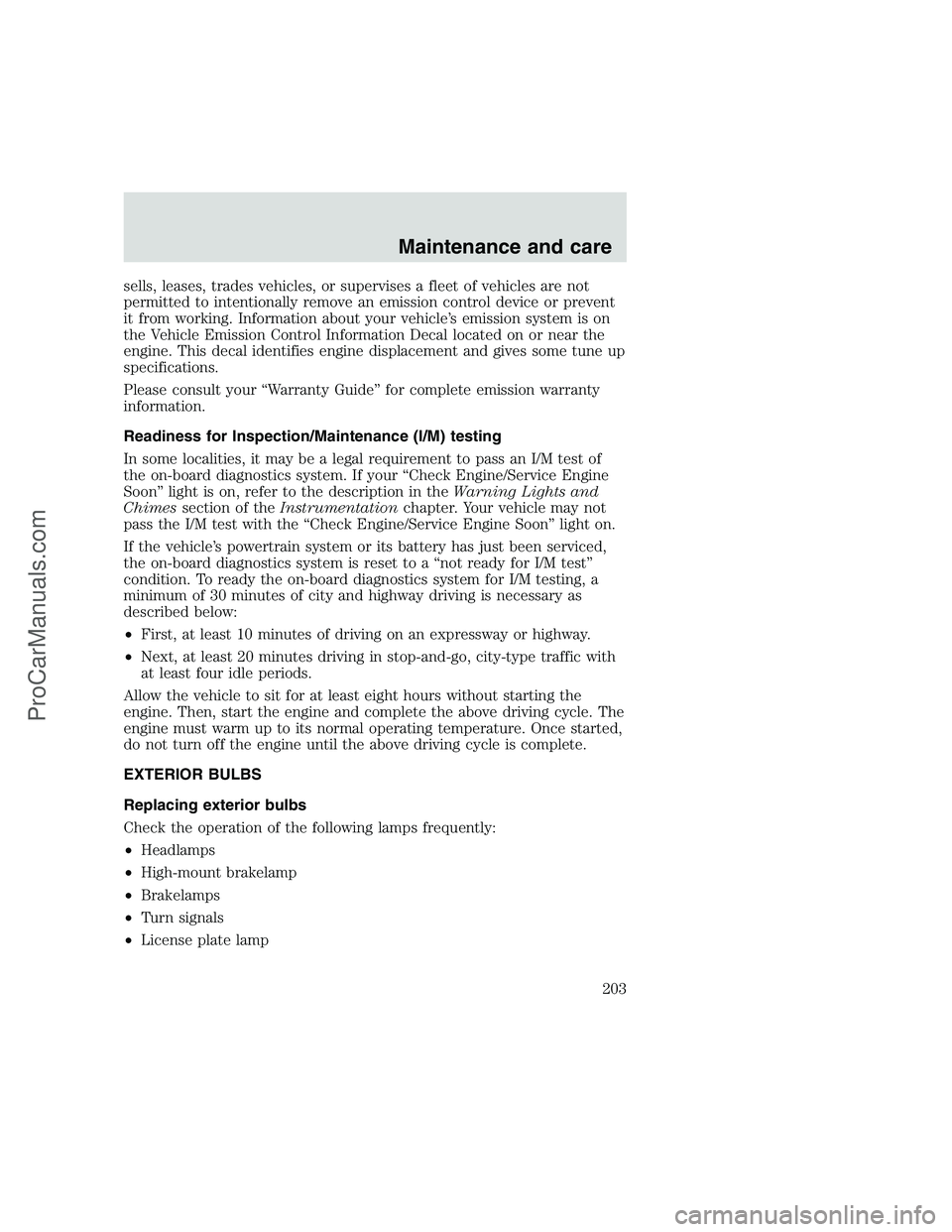
sells, leases, trades vehicles, or supervises a fleet of vehicles are not
permitted to intentionally remove an emission control device or prevent
it from working. Information about your vehicle’s emission system is on
the Vehicle Emission Control Information Decal located on or near the
engine. This decal identifies engine displacement and gives some tune up
specifications.
Please consult your “Warranty Guide” for complete emission warranty
information.
Readiness for Inspection/Maintenance (I/M) testing
In some localities, it may be a legal requirement to pass an I/M test of
the on-board diagnostics system. If your “Check Engine/Service Engine
Soon” light is on, refer to the description in theWarning Lights and
Chimessection of theInstrumentationchapter. Your vehicle may not
pass the I/M test with the “Check Engine/Service Engine Soon” light on.
If the vehicle’s powertrain system or its battery has just been serviced,
the on-board diagnostics system is reset to a “not ready for I/M test”
condition. To ready the on-board diagnostics system for I/M testing, a
minimum of 30 minutes of city and highway driving is necessary as
described below:
•First, at least 10 minutes of driving on an expressway or highway.
•Next, at least 20 minutes driving in stop-and-go, city-type traffic with
at least four idle periods.
Allow the vehicle to sit for at least eight hours without starting the
engine. Then, start the engine and complete the above driving cycle. The
engine must warm up to its normal operating temperature. Once started,
do not turn off the engine until the above driving cycle is complete.
EXTERIOR BULBS
Replacing exterior bulbs
Check the operation of the following lamps frequently:
•Headlamps
•High-mount brakelamp
•Brakelamps
•Turn signals
•License plate lamp
Maintenance and care
203
ProCarManuals.com
Page 236 of 248
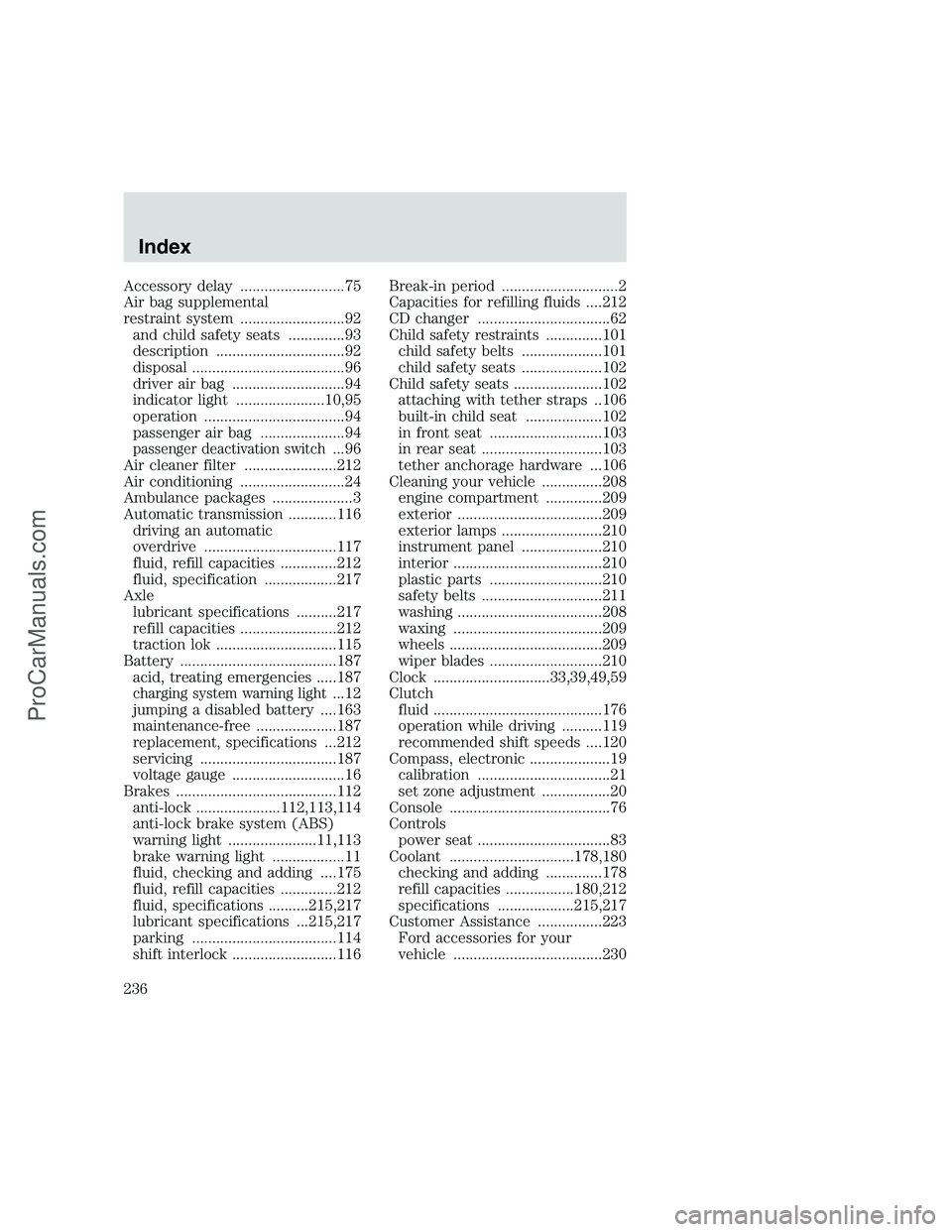
Accessory delay ..........................75
Air bag supplemental
restraint system ..........................92
and child safety seats ..............93
description ................................92
disposal ......................................96
driver air bag ............................94
indicator light ......................10,95
operation ...................................94
passenger air bag .....................94
passenger deactivation switch...96
Air cleaner filter .......................212
Air conditioning ..........................24
Ambulance packages ....................3
Automatic transmission ............116
driving an automatic
overdrive .................................117
fluid, refill capacities ..............212
fluid, specification ..................217
Axle
lubricant specifications ..........217
refill capacities ........................212
traction lok ..............................115
Battery .......................................187
acid, treating emergencies .....187
charging system warning light...12
jumping a disabled battery ....163
maintenance-free ....................187
replacement, specifications ...212
servicing ..................................187
voltage gauge ............................16
Brakes ........................................112
anti-lock .....................112,113,114
anti-lock brake system (ABS)
warning light ......................11,113
brake warning light ..................11
fluid, checking and adding ....175
fluid, refill capacities ..............212
fluid, specifications ..........215,217
lubricant specifications ...215,217
parking ....................................114
shift interlock ..........................116Break-in period .............................2
Capacities for refilling fluids ....212
CD changer .................................62
Child safety restraints ..............101
child safety belts ....................101
child safety seats ....................102
Child safety seats ......................102
attaching with tether straps ..106
built-in child seat ...................102
in front seat ............................103
in rear seat ..............................103
tether anchorage hardware ...106
Cleaning your vehicle ...............208
engine compartment ..............209
exterior ....................................209
exterior lamps .........................210
instrument panel ....................210
interior .....................................210
plastic parts ............................210
safety belts ..............................211
washing ....................................208
waxing .....................................209
wheels ......................................209
wiper blades ............................210
Clock .............................33,39,49,59
Clutch
fluid ..........................................176
operation while driving ..........119
recommended shift speeds ....120
Compass, electronic ....................19
calibration .................................21
set zone adjustment .................20
Console ........................................76
Controls
power seat .................................83
Coolant ...............................178,180
checking and adding ..............178
refill capacities .................180,212
specifications ...................215,217
Customer Assistance ................223
Ford accessories for your
vehicle .....................................230
Index
236
ProCarManuals.com
Page 237 of 248
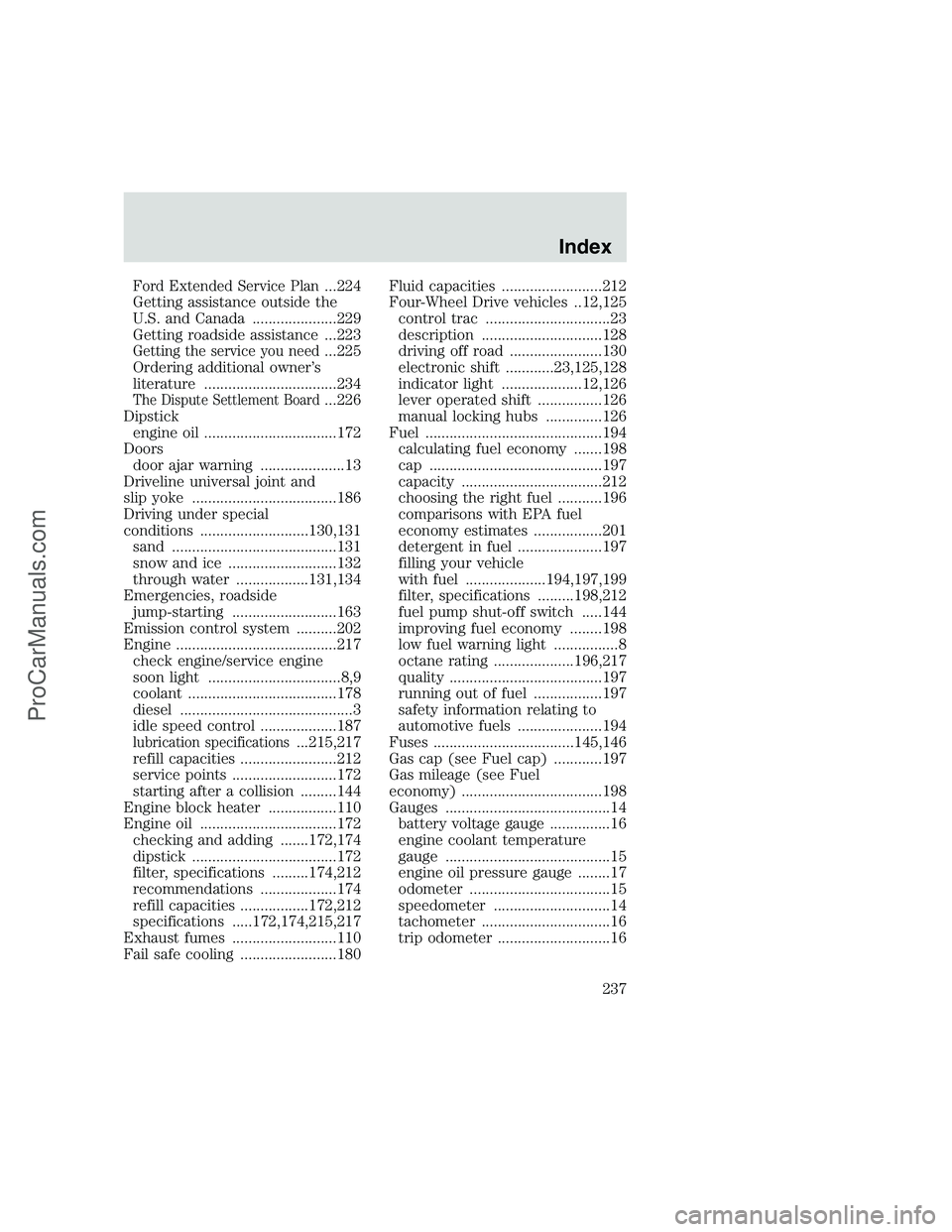
Ford Extended Service Plan...224
Getting assistance outside the
U.S. and Canada .....................229
Getting roadside assistance ...223
Getting the service you need...225
Ordering additional owner’s
literature .................................234
The Dispute Settlement Board...226
Dipstick
engine oil .................................172
Doors
door ajar warning .....................13
Driveline universal joint and
slip yoke ....................................186
Driving under special
conditions ...........................130,131
sand .........................................131
snow and ice ...........................132
through water ..................131,134
Emergencies, roadside
jump-starting ..........................163
Emission control system ..........202
Engine ........................................217
check engine/service engine
soon light .................................8,9
coolant .....................................178
diesel ...........................................3
idle speed control ...................187
lubrication specifications...215,217
refill capacities ........................212
service points ..........................172
starting after a collision .........144
Engine block heater .................110
Engine oil ..................................172
checking and adding .......172,174
dipstick ....................................172
filter, specifications .........174,212
recommendations ...................174
refill capacities .................172,212
specifications .....172,174,215,217
Exhaust fumes ..........................110
Fail safe cooling ........................180Fluid capacities .........................212
Four-Wheel Drive vehicles ..12,125
control trac ...............................23
description ..............................128
driving off road .......................130
electronic shift ............23,125,128
indicator light ....................12,126
lever operated shift ................126
manual locking hubs ..............126
Fuel ............................................194
calculating fuel economy .......198
cap ...........................................197
capacity ...................................212
choosing the right fuel ...........196
comparisons with EPA fuel
economy estimates .................201
detergent in fuel .....................197
filling your vehicle
with fuel ....................194,197,199
filter, specifications .........198,212
fuel pump shut-off switch .....144
improving fuel economy ........198
low fuel warning light ................8
octane rating ....................196,217
quality ......................................197
running out of fuel .................197
safety information relating to
automotive fuels .....................194
Fuses ...................................145,146
Gas cap (see Fuel cap) ............197
Gas mileage (see Fuel
economy) ...................................198
Gauges .........................................14
battery voltage gauge ...............16
engine coolant temperature
gauge .........................................15
engine oil pressure gauge ........17
odometer ...................................15
speedometer .............................14
tachometer ................................16
trip odometer ............................16
Index
237
ProCarManuals.com
Page 238 of 248

GAWR
(Gross Axle Weight Rating) .....132
calculating ...............................134
definition .................................132
driving with a heavy load ......132
location ....................................132
GVWR (Gross Vehicle
Weight Rating) ..........................132
calculating ........................132,134
definition .................................132
driving with a heavy load ......132
location ....................................132
Hazard flashers .........................144
Headlamps ...................................22
aiming ......................................208
daytime running lights .............22
flash to pass .........................23,73
high beam .......................12,22,72
turning on and off ....................22
warning chime ..........................13
Heating ........................................24
heater only system ...................24
heating and air
conditioning system .................26
Hood ..........................................171
Ignition .......................................217
positions of the ignition ...........66
removing the key ....................124
Infant seats (see Safety seats)...102
Inspection/maintenance
(I/M) testing ..............................203
Instrument panel
cleaning ...................................210
lighting up panel and interior....23
location of components ..............8
Jump-starting your vehicle ......163
Keys
key in ignition chime ...............13
positions of the ignition ...........66
Lamps
autolamp system .....................203
cargo lamps ...............................23daytime running light ...............22
headlamps .................................22
headlamps, flash to pass .....23,73
instrument panel, dimming .....23
replacing
bulbs ............203,204,205,206,207
Lane change indicator
(see Turn signal) ........................66
Lights, warning and indicator ......8
air bag ........................................10
anti-lock brakes (ABS) .....11,113
brake ..........................................11
charging system ........................12
check coolant ............................13
door ajar ....................................13
engine oil pressure ...................13
high beam .................................12
low fuel ........................................8
safety belt .................................11
service engine soon .................8,9
turn signal indicator .................12
Load limits .................................132
GAWR ......................................132
GVWR ......................................132
trailer towing ..........................132
Lubricant specifications ....215,217
Lumbar support, seats ...............84
Manual transmission .................119
fluid capacities ........................212
lubricant specifications ..........217
Message center ...........................17
english/metric button ...............17
menu button .............................18
Mirrors
fold away ...................................76
side view mirrors (power) .......75
Motorcraft parts .................198,212
Octane rating ............................196
Odometer .....................................15
Overdrive .....................................73
Panic alarm feature,
remote entry system ..................78
Index
238
ProCarManuals.com